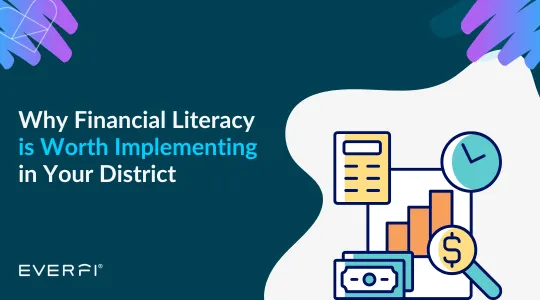Why Financial Literacy Is Worth Implementing in Your District


If you were to create a list of the top ten life skills students need to learn, I’m willing to bet that financial literacy would be on it. Without a strong foundation in financial literacy, students may end up drowning in debt and denying themselves some amazing opportunities.
That’s why over half the states in the country now require completion of a personal finance course as a prerequisite to graduation.
Whether you need to create such a course from scratch or supplement your existing financial literacy curricula, this blog will provide you with five benefits of financial literacy (a few of which you may not have thought of) and show you how teachers can access a free suite, of award-winning and standards-aligned resources for free!
Why is financial literacy important for youth? The short answer is that, as educators, we are responsible for preparing our students for success in and outside of academics altogether.
It’s not enough to simply prepare them for college; they need to know about setting financial goals and managing money in a healthy way.
With proper financial literacy instruction, you can provide students with invaluable information about budgeting and avoiding debt pitfalls like high-interest credit cards. You can also instill in them the value of having a proper savings account as a way of avoiding debt. Speaking of debt, an early grounding in financial literacy for teenagers now can help them avoid taking on unnecessary college debt that could potentially follow them for decades.
Financial literacy instruction gives students the confidence to make wise financial decisions leading to less financial stress in their lives, even as it prepares them to be productive members of their local communities.
Schools are understandably hesitant about investing in new things because administrators focus on the big question: How will this investment of time and money benefit students? Fortunately, there are numerous benefits of financial literacy courses for students. The information they learn from such courses is useful while they are students and will continue to be useful long after they settle down and begin raising families of their very own.
What kind of information are we talking about, though, and how will a more formal financial literacy education help your own students? Below, you’ll find a breakdown of the chief benefits this financial planning instruction can have on your student body.
A primary goal of public education is to give everyone an even playing field. When everyone has the same level of knowledge, they theoretically have the same number of opportunities. However, students who graduate high school and don’t have answers to questions like “What is a budget?” or “How much should I borrow for college? “are going to be far less equipped to succeed than those who already have those answers.
By making financial literacy part of your curriculum, you can help close any knowledge gaps the students may have.
This is particularly important for students of low socioeconomic status who may not have the resources to learn this information outside of school. Providing this education to them will be empowering and may open educational and vocational doors that would otherwise stay closed.
One goal shared by every high school is for the students to be high performers whose academic achievements help them succeed. But would you believe that better academic performance starts with better financial literacy?
Previous studies(opens in new tab) have found that “financial stress lowers students’ academic performance” and “financial stress has been linked to students’ decisions to reduce their course loads, withdraw from college completely to pursue full-time employment, and increase time to graduation.” By providing better financial literacy skills to students early on, it’s possible to improve their academic scores and better position them for educational success now and in the future.
Additionally, improved financial literacy can help students avoid the financial stressors that may further decrease academic performance. Various studies have shown that financial literacy education does more than help students avoid credit card debt and student loan debt. One recent study found that teens who received financial literacy education in school were better at managing their finances into their adulthood. Furthermore, a 2020 study found that young people 18-21 who received three years of financial literacy education were 40% less likely to fall behind on credit card payments and had credit scores about 25 points higher than those who didn’t take such courses.
In short, students who worry less about financial woes can focus more on their education, further improving school performance.
These courses also help students perform better in school and improve higher education student retention. Therefore, the question “Why is financial literacy important for students?” has one more surprising answer: such literacy has just as much of an impact on a student’s schoolwork and ability to focus as it does on their ability to budget and save.
A big goal of high school educators is to prepare students for a successful college career. However, academic success doesn’t necessarily prepare students for the high cost of higher education. That could lead to expensive loans that, if improperly managed, can sink the student into potentially life-changing debt.
Studies have shown that:
Had these borrowers received better financial literacy preparation in middle school and high school, they would be in a better position to avoid debt that will potentially haunt them for decades and make it harder to buy cars, homes, or generally enjoy a high quality of living.
Fortunately, Everfi provides K-12 schools with completely free access to its standards-aligned financing higher education lessons, Pathways.
Over 2,000 schools have used the digital resource to teach topics like:
Some quick stats from the over 100,000 students who completed last year:
Almost everyone has the same general financial goals. For example, they want to make enough money for themselves and maybe a family, and they want to stretch available funds as far as they will go. Unfortunately, many students have trouble meeting their goal of financial stability because they fall prey to various myths and misconceptions about finances and financial management.
Students are often the victims of get-rich-quick schemes and predatory credit card lenders. Even worse, it can be difficult to undo the damage of early financial mistakes. With a financial literacy program in high school, students can easily debunk these myths and take the right step on the road toward financial security.
Other major benefits of early financial literacy education include the following:
Some administrators are hesitant to implement a financial literacy program because they worry it will clash with the rest of the curriculum. In other words, they worry that teaching skills like budgeting and money management will detract from time that could be spent teaching students various core curriculum skills.
However, the truth is that the right financial literacy programs will actually reinforce much of the core curriculum. For example, students will learn about the intimate connection between math and economics, and understanding more about how people can be taken advantage of by major companies through deceptive advertising is an important lesson in modern social studies. Finally, learning creative ways to put all of this information together to protect themselves helps foster critical thinking skills among the student body.
Now, you know more about the benefits of financial literacy courses for high school students. However, you might worry about the time and cost of creating such a program from scratch.
Fortunately, you don’t have to reinvent the wheel because Everfi has a growing library of free financial literacy lessons for you and your students to use.
Everfi’s digital resources are aligned to state & national Jump$tart standards for grades 3-12. Their interactive lessons cover topics such as:
They are easy to integrate into any grade level and can be adapted for elementary, middle school, and high school students. The turnkey resources are so easy to use that teachers can get their students learning in under 10 minutes!
You may be a bit skeptical that Everfi can provide the full suite of financial literacy resources your own students deserve at absolutely no cost. It sounds too good to be true, and that may make you wary. But it might help you to know that over 60% of the nation’s school districts use Everfi’s award-winning resources to help their students.
For example, Everfi was able to supercharge the financial literacy education of Prince George’s County Public Schools in Maryland. The district wanted more resources to meet graduation requirements but was faced with staffing shortages that impacted the ability to train teachers.
Thanks to Everfi’s District Support team, 153 teachers received group and personalized training in 58 schools as well as free 24/7 support. The district was so pleased with the platform and support that they expanded Everfi’s resources into their middle and elementary schools.
Ready to add a financial literacy program to your own school or district? That’s great news! More awesome news: Taking that first step is easier than you might think.
All you have to do is meet with our Everfi support team.
These specialists are prepared to help administrators create robust financial literacy programs that will benefit students in every school. A quick call with Everfi will provide you with a demo of our free resources, an understanding of how other districts in your area are using them, and the support that Everfi can provide your district; all at no cost.
Having free, high-quality financial literacy resources can provide your students with benefits that will last a lifetime. Everfi’s award-winning digital lessons are as engaging as they are impactful.
In addition to its free lessons, Everfi provides districts with free:
3 out of 5 districts rely on Everfi to help prepare today’s students for the challenges of tomorrow. Make yours one of them and give your teachers & students the resources and support that they deserve!
“Financial literacy is an important life skill that Everfi is providing our students free of cost. Every high school student in America needs to be exposed to this course. I am so glad my students have an opportunity to learn this valuable life skill through Everfi.” – High School Teacher, GA
Thanks to partners, we provide our digital platform, training, and support at no cost.
See why 3 out of 5 districts partner with Everfi.
Everfi uses anonymous data provided by cookies to improve site navigation, analyze site usage, and assist in our marketing efforts. Click to accept or choose your opt-out preferences.


